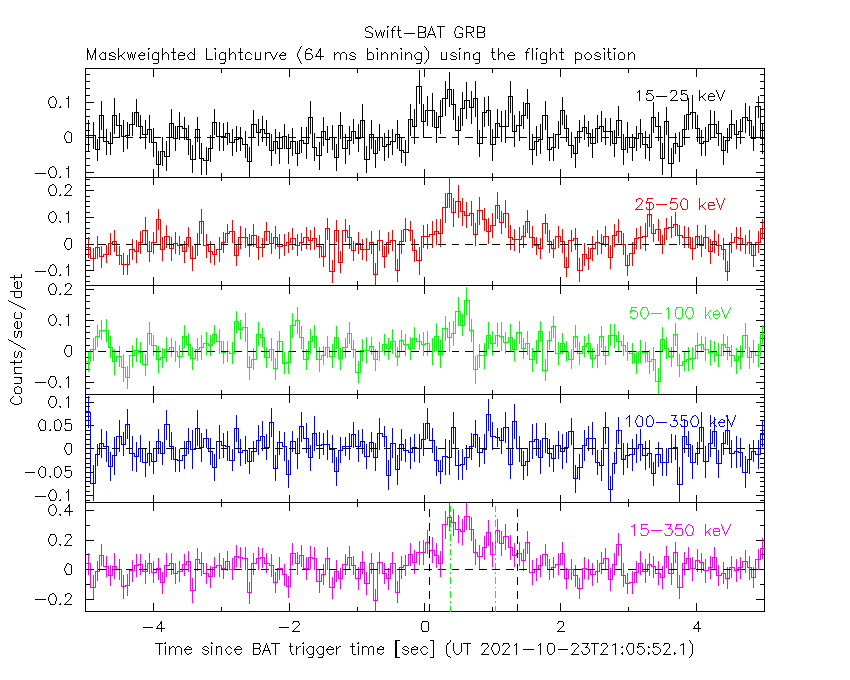
S. Dichiara (NASA/GSFC/UMCP), A.P. Beardmore (U. Leicester) and N.P.M. Kuin (UCL-MSSL) for the Swift team
At 21:05:52 UT, the Swift Burst Alert Telescope (BAT) triggered and located GRB 211023B (trigger=1080859) (Dichiara et al. GCN Circ. 30960). Swift slewed immediately to the burst. At the time of the trigger, the initial BAT position was 62° from the Sun (2.5 hours West) and 88° from the 91%-illuminated Moon. Table 1 contains the best reported positions from Swift, and the latest XRT position can be viewed at http://www.swift.ac.uk/xrt_positions.
Dichiara et al. (GCN Circ. 30960) reported the discovery with UVOT of an optical afterglow. Rossi et al. (GCN Circ. 31107) determined a redshift of 0.862 from LBT. Table 2 is a summary of GCN Circulars about this GRB from observatories other than Swift.
Standard analysis products for this burst are available at https://gcn.gsfc.nasa.gov/swift_gnd_ana.html.
As reported by Laha et al. (GCN Circ. 30979),
the BAT ground-calculated position is RA, Dec = 170.314, 39.133 deg which is RA(J2000) = 1
The mask-weighted light curve (Figure 1) s shows a single peak from approximately T+0 to T+1.5 seconds.
The time-averaged spectrum from T-0.01 to T+1.45 s is best fit by a simple power-law model.
The power law index of the time-averaged spectrum is 1.97 ± 0.24.
The fluence in the 15-150 keV band is 1.7 ± 0.3 x 1
The results of the batgrbproduct analysis are available at https://gcn.gsfc.nasa.gov/notices_s/1080859/BA/.
Analysis of the initial XRT data was reported by Beardmore et al. (GCN Circ. 30967). We have analysed 27 ks of XRT data for GRB 211023B, from 79 s to 396.3 ks after the BAT trigger. The data comprise 8 s in Windowed Timing (WT) mode (taken while Swift was slewing), with the remainder in Photon Counting (PC) mode. The enhanced XRT position for this burst was given by Beardmore et al. (GCN Circ. 30966).
The light curve (Figure 2) can be modelled with a power-law decay with a decay index of α=0.95 (+0.10, -0.08).
A spectrum formed from the PC mode data can be fitted with an absorbed power-law with a photon spectral index of 2.12 (+0.23, -0.21). The best-fitting absorption column is 1.1 (+0.6, -0.5) x 1
A summary of the PC-mode spectrum is thus:
Total column: 1.1 (+0.6, -0.5) x 1
Galactic foreground: 2.3 x 1
Excess significance: 2.9 σ
Photon index: 2.12 (+0.23, -0.21)
The results of the XRT team automatic analysis are available at http://www.swift.ac.uk/xrt_products/01080859.
The Swift/UVOT began settled observations of the field of GRB 211023B 98 s after the BAT trigger
(Kuin and Dichiara GCN Circ. 30975).
A source consistent with the XRT position (Beardmore et al. GCN Circ. 30966) is detected in the initial UVOT exposures.
Table 3 gives preliminary
magnitudes using the UVOT photometric system
(Breeveld et al. 2011, AIP Conf. Proc., 1358, 373).
No correction has been made for the expected extinction in the Milky Way
corresponding to a reddening of

Figure 1. The BAT
mask-weighted light curve in the four individual and total
energy bands. The units are counts

Figure 2. The XRT light curve.
Any data from a crosshatched region are not included in the fit.
| RA (J2000) | Dec (J2000) | Error | Note | Reference |
|---|---|---|---|---|
| 1 |
+39°08'08.8" | 0.53" | UVOT-refined | Kuin and Dichiara GCN Circ. 30975 |
| 1 |
+39°08'07.2" | 2.7" | XRT-final | UKSSDC |
| 1 |
+39°08'07.2" | 2.7" | XRT-enhanced | Beardmore et al. GCN Circ. 30966 |
| 1 |
+39°07'58.7" | 2.0' | BAT-refined | Laha et al. GCN Circ. 30979 |
| Band | Authors | GCN Circ. | Subject | Observatory | Notes |
|---|---|---|---|---|---|
| Optical | Lipunov et al. | 30964 | Swift GRB 211023B: Global MASTER-Net observations report |
MASTER | |
| Optical | Pozanenko et al. | 30972 | TSHAO optical observation | Zeiss-1000 | |
| Optical | Watson et al. | 30973 | RATIR Optical and NIR Upper Limits | RATIR | upper limits |
| Optical | Hu et al. | 30976 | BOOTES-4/MET and 1.5m OSN optical upper limit |
BOOTES-4 | upper limits |
| Optical | Kann et al. | 30992 | Possible Short GRB 211023B: CAHA 2.2m Detection |
CAHA | possible detection |
| Optical | O'Connor et al. | 31000 | LDT Optical Afterglow Detection | Lowell Discovery Telescope | detection |
| Optical | Rastinejad et al. | 31002 | Gemini-North Optical Observations | Gemini | |
| Optical | Pozanenko et al. | 31003 | Mondy optical afterglow confirmation | Mondy | detection |
| Optical | Grossan et al. | 31016 | NUTTelA-TAO / BSTI Early Optical Limits (Preliminary) |
NUTTelA | upper limits |
| Optical | Hosokawa et al. | 31031 | MITSuME Akeno optical upper limits | MITSuME Akeno | upper limits |
| Optical | Sakamoto et al. | 31038 | Subaru optical observation | Subaru | |
| Optical | Rossi et al. | 31107 | LBT likely spectroscopic redshift of the host galaxy |
LBT | redshift |
| Filter | Exp(s) | Mag | ||
|---|---|---|---|---|
| white | 98 | 247 | 147 | 19.44 ± 0.11 |
| v | 640 | 1753 | 136 | >18.8 |
| b | 566 | 1679 | 117 | >19.9 |
| u | 310 | 734 | 265 | 19.50 ± 0.20 |
| w1 | 690 | 1803 | 117 | >19.3 |
| w2 | 615 | 1039 | 39 | >19.9 |
Table 3. UVOT observations reported by Kuin and Dichiara (GCN Circ. 30975). The start and stop times of the exposures are given in seconds since the BAT trigger. The preliminary detections and 3-σ upper limits are given. No correction has been made for extinction in the Milky Way.
November 24, 2021